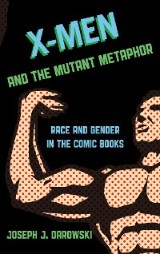Details

X-Men and the Mutant Metaphor
Race and Gender in the Comic Books|
97,99 € |
|
| Verlag: | Rowman & Littlefield Publishers |
| Format: | EPUB |
| Veröffentl.: | 10.04.2014 |
| ISBN/EAN: | 9781442232082 |
| Sprache: | englisch |
| Anzahl Seiten: | 242 |
DRM-geschütztes eBook, Sie benötigen z.B. Adobe Digital Editions und eine Adobe ID zum Lesen.
Beschreibungen
<span><span>First appearing in 1963, </span><span>The Uncanny X-Men</span><span> had a rough start, lasting until 1970 when the comic book was canceled due to low sales. Following a relaunch in 1975, however, it found new popularity thanks to intricate scripting by Chris Claremont and the artwork of John Byrne. Within a few years, </span><span>The Uncanny X-Men</span><span> was one of Marvel Comics’ best-selling series and over the decades it became one of the most successful and popular franchises in comic book history. Spin-off titles, mini-series, multimedia adaptations, and a massively expanded cast of characters followed. One of the reasons for the success of X-Men is its powerful “mutant metaphor,” which enhances the stories with cultural significance and the exploration of themes such as societal prejudice and discrimination.<br><br>In </span><span>X-Men and the Mutant Metaphor: Race and Gender in the Comic Books</span><span>, Joseph J. Darowski thoroughly analyzes </span><span>The Uncanny X-Men</span><span>, providing its historical background and dividing the long-running series into distinct eras. Each chapter examines the creators and general plot lines, followed by a closer analysis of the principal characters and key stories. The final chapter explores the literal use of race and gender rather than the metaphorical or thematic ways such issues have been addressed. This analysis includes insights gained from interviews with several comic book creators, and dozens of illustrations from the comic book series. Of particular significance are statistics that track the race and gender of every X-Men hero, villain, and supporting character. By delving into the historical background of the series and closely examining characters and stories, </span><span>X-Men and the Mutant Metaphor</span><span> illuminates an important popular culture phenomenon.</span></span>
<span><span>Among both fans and the academic community, there is a general assumption that the X-Men franchise is one of the most progressive and inclusive superhero comic books that has been published. However, this study challenges such assumptions, revealing that there is an unfortunate trend throughout the majority of the title’s history: Minority characters are most likely to be villains, female characters are most likely to be supporting cast members, and white males are most likely to be members of the X-Men.</span></span>
<span><span>Introduction</span></span>
<br>
<span></span>
<br>
<span><span>Chapter 1: Understanding the X-Men</span></span>
<br>
<span><span>Chapter 2: Intriguing Concept, Uneven Execution: </span><span>The X-Men #1 </span><span>(Sep. 1963) – </span><span>X-Men #66</span><span>(Mar. 1970)</span></span>
<br>
<span><span>Chapter 3 Relaunching and Reimagining: </span><span>Giant-Size X-Men #1</span><span> (May 1975) - </span><span>The Uncanny X-Men #166</span><span> (Feb. 1983)</span></span>
<br>
<span><span>Chapter 4: Adding Depth and Exploring Prejudice: </span><span>The Uncanny X-Men #167</span><span> (Mar. 1983) – </span><span>The Uncanny X-Men</span><span>#280 </span><span>(Sep. 1991)</span></span>
<br>
<span><span>Chapter 5: Broadening the Mutant Metaphor: </span><span>The Uncanny X-Men #281</span><span> (Oct. 1991) – </span><span>The Uncanny X-Men #393</span><span> (Jun. 2001)</span></span>
<br>
<span><span>Chapter 6: Reestablishing the Metaphor: </span><span>The Uncanny X-Men #394</span><span> (Jul. 2001) – </span><span>The Uncanny X-Men #500 </span><span>(Sep. 2008)</span></span>
<br>
<span><span>Chapter 7: By the Numbers </span></span>
<br>
<span></span>
<br>
<span><span>Conclusion</span></span>
<br>
<span><span>Appendix A</span></span>
<br>
<span><span>Appendix B</span><a></a></span>
<br>
<span><span>Works Cited</span></span>
<br>
<span><span>Index</span></span>
<br>
<span><span>About the Author</span></span>
<br>
<span></span>
<br>
<span><span>Chapter 1: Understanding the X-Men</span></span>
<br>
<span><span>Chapter 2: Intriguing Concept, Uneven Execution: </span><span>The X-Men #1 </span><span>(Sep. 1963) – </span><span>X-Men #66</span><span>(Mar. 1970)</span></span>
<br>
<span><span>Chapter 3 Relaunching and Reimagining: </span><span>Giant-Size X-Men #1</span><span> (May 1975) - </span><span>The Uncanny X-Men #166</span><span> (Feb. 1983)</span></span>
<br>
<span><span>Chapter 4: Adding Depth and Exploring Prejudice: </span><span>The Uncanny X-Men #167</span><span> (Mar. 1983) – </span><span>The Uncanny X-Men</span><span>#280 </span><span>(Sep. 1991)</span></span>
<br>
<span><span>Chapter 5: Broadening the Mutant Metaphor: </span><span>The Uncanny X-Men #281</span><span> (Oct. 1991) – </span><span>The Uncanny X-Men #393</span><span> (Jun. 2001)</span></span>
<br>
<span><span>Chapter 6: Reestablishing the Metaphor: </span><span>The Uncanny X-Men #394</span><span> (Jul. 2001) – </span><span>The Uncanny X-Men #500 </span><span>(Sep. 2008)</span></span>
<br>
<span><span>Chapter 7: By the Numbers </span></span>
<br>
<span></span>
<br>
<span><span>Conclusion</span></span>
<br>
<span><span>Appendix A</span></span>
<br>
<span><span>Appendix B</span><a></a></span>
<br>
<span><span>Works Cited</span></span>
<br>
<span><span>Index</span></span>
<br>
<span><span>About the Author</span></span>
<span><span>Joseph J. Darowski</span><span> is a member of the English department at Brigham Young University Idaho. He is the editor of a series of essay collections entitled </span><span>The Ages of Superheroes</span><span> which has included volumes on Superman and Wonder Woman.</span></span>
Diese Produkte könnten Sie auch interessieren:

Besonderheiten der Unternehmensbewertung in der Film- und Fernsehindustrie

von: Insa Niemeyer

48,00 €















